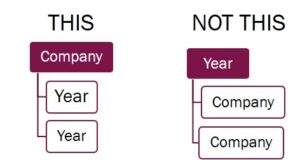 Those who gave feedback on file structure, or organization scheme, for your assets and memories seem to think in terms of either project files or non-project files. By project files, I mean everything that has to do with an individual recruiting, retention, or expansion project. Non-project files tend to include everything from marketing materials to administrative records.
Those who gave feedback on file structure, or organization scheme, for your assets and memories seem to think in terms of either project files or non-project files. By project files, I mean everything that has to do with an individual recruiting, retention, or expansion project. Non-project files tend to include everything from marketing materials to administrative records.
Project files seem pretty straightforward, except for one thing – projects often start out with code names and then, if they work out well, transfer to the name of the company involved. That’s actually the good news, assuming that the file names get translated at some point. Notice what I said there, it takes an intentional effort to keep this stuff straight. It works best when there is a single point in time, maybe at the announcement if there is one, that you go back and find everything, starting from that initial marketing presentation that may have generated the lead, all the associated emails, and put them in one place with the public name of the project. If you are diligent, you could then have something like this for project files:
Business retention/expansion files are pretty straightforward too – it’s pretty easy to aggregate all of the material related to one of your existing companies. Since you have ongoing relationships with them, it makes sense for the structure to look like:
The tricky ones are the prospects or projects that stay in code name form. This happens often when there is no definite end to the efforts, or when a project is “lost”. what happens when no one is around any more who has any memory of “Project X” if it comes back around again?
Some people take another approach and organize files in folders by year – so what is important there is to have an understanding of what your protocol really is – what are the rules of the road when a project extends across multiple years, as many do? Or what about the projects that inevitably get put on hold then resurface later, as many do?
At a minimum, it seems to be a good idea to create a catalogue of sorts, even an excel file, that sits with all of your folders as serves as the secret decoder ring for those that come after you.
Folders identified by date also seem to be the most popular file structure for non-project assets like photos, videos, logos, and the marketing collateral they are used in. Subject matter organization seems to be reserved for site specific material – for example, any digital assets that relate to a specific site or building.
I’ll go a little deeper into ways you can make sure the search process for that one photo or graph you remember doesn’t turn a wild goose chase in the next post about filters and tagging.


